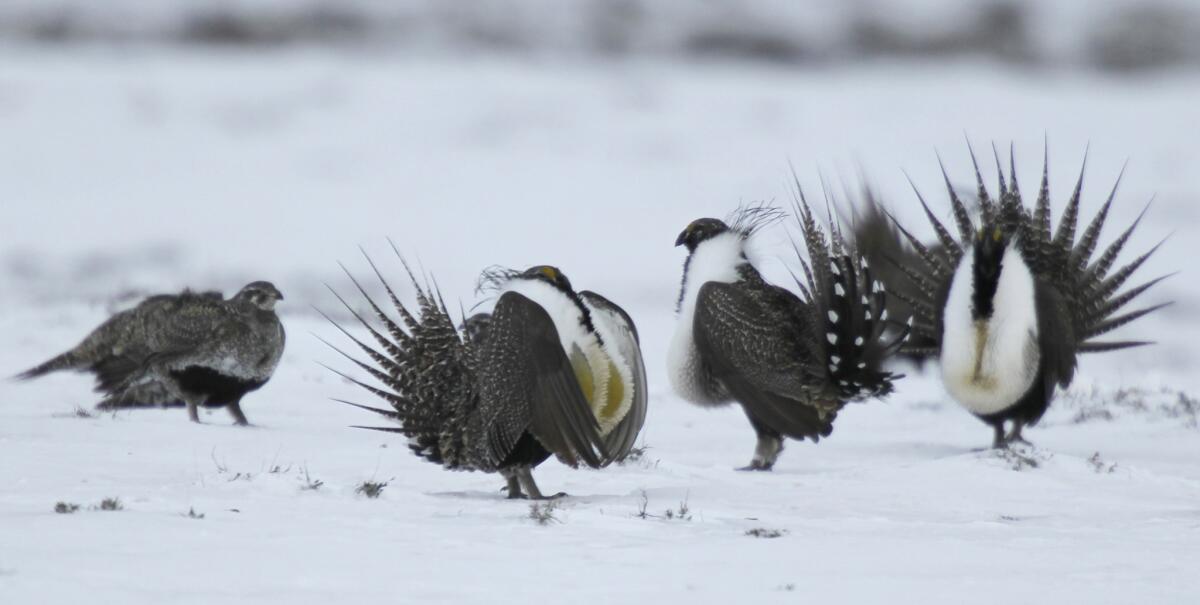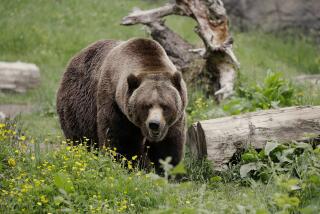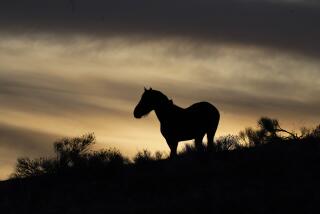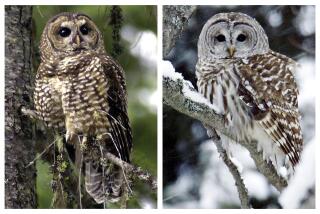Feds to restrict grazing, other activities on public lands to save sage grouse in the West

Reporting from denver — Federal land managers have issued guidelines for restricting energy development, livestock grazing and other activities on public land in the West to protect the greater sage grouse, part of a broad effort to save the bird without resorting to listing it as an endangered species.
The Bureau of Land Management guidelines tell field employees when and how to apply new rules under a sweeping conservation plan announced last year.
That plan is designed to keep the distinctive ground-dwelling bird from being listed as endangered or threatened, which could bring down tougher restrictions and provoke a political backlash against the Endangered Species Act.
But Rep. Rob Bishop (R-Utah), chairman of the House Committee on Natural Resources, denounced the guidelines and called the sage grouse conservation plan a ploy by the Obama administration to block energy development and commandeer state conservation plans.
“These plans, written as if the sage grouse were listed, are proof it was an underhanded, de facto listing scheme that further oppresses Western states,” Bishop said in a written statement.
Among other things, the new guidelines tell BLM employees who review oil and gas drilling permit applications to start with applications for land outside important sage grouse habitat. Proposals for drilling on the most sensitive land would be processed last.
The guidelines instruct BLM staff to review livestock grazing permits in the most sensitive areas first, to see whether new protections are needed.
The guidelines, released Thursday, cover about 95,000 square miles of land overseen by the BLM. The U.S. Forest Service and state agencies are drawing up their own plans for land they manage.
Greater sage grouse live in 11 Western states. About 200,000 to 500,000 remain, down from a peak population of about 16 million.
BLM Director Neil Kornze said the guidelines are designed to be consistent but still give field offices the flexibility to respond to local conditions.
Like every step the government takes on sage grouse, the guidelines prompted criticism from both sides as well as some words of praise.
The National Wildlife Federation welcomed them, calling them an important step toward putting last year’s conservation plan into effect. “Let’s give those plans a chance to work,” said Kate Zimmerman, the group’s public lands specialist.
Other environmental groups said the guidelines were too flexible, too slow to take effect and too focused on making plans instead of taking measures to save the birds.
“The delay and the wiggle room built into these plans is not going to protect the sage grouse from the ongoing impact of livestock grazing,” said Greta Anderson of the Western Watersheds Project.
Kathleen Sgamma of the Western Energy Alliance, an oil and gas industry group, called the priority system arbitrary and said it ignores work that companies have done to protect sage grouse.
“This is another example of draconian federal measures that ignore actual on-the-ground measures that states, counties, landowners and companies are already doing to conserve the species,” Sgamma said.
Elliott writes for Associated Press.
ALSO
Sage grouse to be saved with ‘largest, most complex land conservation effort ever’
Tenacious, mysterious and maybe endangered—a wolverine roams the West
With echoes of Wounded Knee, tribes mount prairie occupation to block North Dakota pipeline
More to Read
Sign up for Essential California
The most important California stories and recommendations in your inbox every morning.
You may occasionally receive promotional content from the Los Angeles Times.










